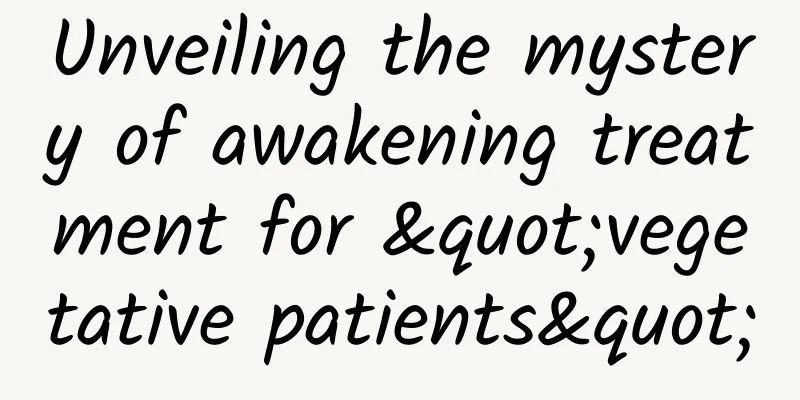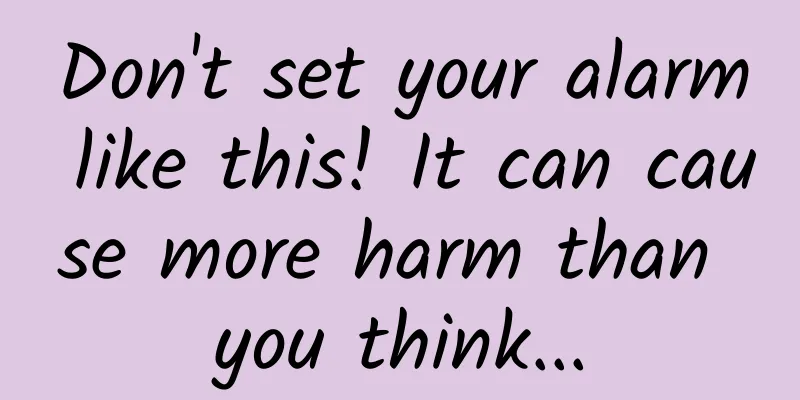Unveiling the mystery of awakening treatment for "vegetative patients"

|
Author: Xu Long, deputy chief physician, Beijing Tiantan Hospital, Capital Medical University Reviewer: He Jianghong, Chief Physician, Beijing Tiantan Hospital, Capital Medical University Every year, thousands of people in the world fall into a coma due to various unfortunate accidents and diseases, thus becoming "vegetative state". Many people are curious about the awakening treatment of "vegetative state" and think that awakening of vegetative state is very mysterious. Today, let's find out and unveil the mystery of "vegetative state" and its awakening treatment. 1. What is a "vegetative state"? What is "disordered consciousness"? In the medical community at home and abroad, as early as the 1970s, if a patient fell into a coma for various reasons and lasted for more than 1 month, it was defined as a "persistent vegetative state" (PVS); usually due to craniocerebral trauma, cerebral hemorrhage or other reasons, such as drowning, infarction, suffocation, cerebral ischemia and hypoxia, neuronal degeneration, etc. Among them, severe craniocerebral injury is the most common cause. Later, with the advancement of brain function detection technology, people found that the brain function activity of "vegetative patients" is not "stagnant", and through advanced detection technologies such as neuroimaging and electrophysiology, their brain activity can be detected, and "awakening" can be achieved through appropriate intervention and treatment measures. Therefore, in recent years, we have gradually abandoned the term "vegetative patient" and replaced it with "disorders of consciousness" (DOC). Among them, those who are in a coma for more than 4 weeks are called chronic disorders of consciousness. Patients with impaired consciousness are unable to have effective functional communication with the outside world and their families. Although they can swallow food, fall asleep and wake up, they cannot distinguish between day and night. They may have eye movements, but cannot control the movement of their limbs independently. They completely lose the ability to take care of themselves, but can retain basic body survival functions such as metabolism and growth and development. Figure 1 Copyright image, no permission to reprint 2. Can doctors determine the awakening of patients with impaired consciousness? The assessment of brain function in patients with impaired consciousness is still a difficult problem that plagues the medical community. The current conventional practice is to adopt a method that combines clinical evaluation, imaging evaluation and electrophysiological evaluation to comprehensively determine the brain function level of patients with impaired consciousness. Objectively speaking, on the one hand, this field is still being studied in depth, and on the other hand, professional hospitals and medical staff are needed to obtain more accurate assessment results through professional functional examination equipment testing and evaluation. However, for the ultimate question often asked by the patient's family: "Can the patient wake up?" Unfortunately, there is currently no clinical indicator that can accurately predict whether a patient with impaired consciousness can wake up. A more realistic approach is to do a good job of clinical evaluation, neuroimaging, and electrophysiological evaluation, and combine the doctor's own experience to give patients with impaired consciousness a suitable awakening treatment plan in order to obtain the best treatment effect. We need to remind everyone that within one month after a patient's brain injury, doctors should try not to make a brain function assessment on whether the patient can be revived. This is because during this period, many patients are in the ICU for critical care or in the transition period after critical care, and they have many complications, such as pneumonia, which will affect the results and assessment of functional tests. 3. Can patients with impaired consciousness be saved? "Can patients with impaired consciousness be saved?" The answer is of course yes. Changing the name from "vegetative state" to "disordered consciousness" is, in a sense, giving doctors, patients and their families more confidence. In the past 20 years, researchers have found that in some patients who appear to be in a "vegetative state", under certain conditions and through specific stimulation detection methods, they can show certain "awake reactions", such as eye visual tracking, limb reaching reactions, etc. Such patients are defined as minimally conscious state (MCS). More and more studies have shown that compared with patients in a vegetative state who are in a worse state, patients in a minimally conscious state have a higher probability of awakening, and it is more worthy of actively taking various awakening measures. 4. What are the treatment methods for “awakening” patients with impaired consciousness? Objectively speaking, there is no so-called "special effect" single "awakening treatment" for consciousness disorder, but based on the need to treat a large number of patients with consciousness disorder, clinical physicians have been conducting research and attempts on the treatment of patients with consciousness disorder. The main treatment methods currently include: drug-assisted therapy (such as amantadine, dobase hydrazine, zolpidem, etc.), hyperbaric oxygen therapy, and neuromodulation therapy. Among them, neuromodulation therapy plays an increasingly important role, including non-invasive neuromodulation (non-surgical) and invasive neuromodulation (surgical). Non-invasive neuromodulation therapy mainly includes: transcranial magnetic stimulation, transcranial electrical stimulation, peripheral nerve electrical stimulation, etc.; invasive neuromodulation therapy mainly includes: deep brain electrical stimulation, spinal cord electrical stimulation, vagus nerve electrical stimulation and other surgeries. It should be noted that patients with consciousness disorder must adopt appropriate awakening treatment plans after individualized evaluation by professional medical institutions. Generally speaking, neuromodulation surgery is a supplement to conventional treatment, and patients should be recommended to undergo conventional rehabilitation and non-invasive neuromodulation treatment first. When the consciousness level reaches a plateau after conventional comprehensive rehabilitation treatment and cannot make further progress, neuromodulatory surgery can be chosen. A careful individualized assessment is required before surgery to select the appropriate awakening neuromodulatory surgery method. 5. Where should patients with impaired consciousness be treated? Family members of patients with impaired consciousness often say: "Doctor, our patients are in such a serious coma that we dare not let them leave the intensive care unit (ICU)." In fact, this idea is wrong. Whether patients with impaired consciousness need to be treated in the intensive care unit all the time must be evaluated based on the individual situation of the patient. If the patient does have life-threatening complications or needs the support of ICU rescue equipment such as a ventilator, then treatment in the ICU is necessary. However, if the patient is no longer in danger of life and is only in a chronic disorder of consciousness, it is not appropriate to continue to stay in the ICU for treatment at this moment. Because at this stage, what is needed is comprehensive rehabilitation treatment of brain function, including hyperbaric oxygen, rehabilitation, non-invasive neuromodulation and other measures. These treatments are inconvenient to carry out in the ICU ward, not to mention the expensive treatment costs and extremely high risk of cross-infection in the ICU. Our view is that the comprehensive awakening treatment of patients with impaired consciousness should be implemented in different wards or medical units at different stages with the goal of achieving a phased treatment plan. Simply put, when life is in danger, the patient needs to be in the ICU. When the condition improves and rehabilitation treatment is needed, the patient should be quickly transferred to a general rehabilitation ward or rehabilitation hospital. Those who need neuromodulation surgery and do not respond well to conventional rehabilitation treatment can be transferred to a higher-level hospital or surgical ward with conditions for surgery. After the awakening treatment is successful, the patient can continue targeted functional rehabilitation at home according to his or her own situation. 6. How can patients with impaired consciousness achieve the best treatment results? In summary, the awakening treatment of "vegetative state" is not mysterious. However, the situation of each "vegetative state" is different. The treatment of consciousness disorder is not only a multidisciplinary system engineering, but also requires individualized evaluation of clinical evaluation, neuroimaging, and electrophysiological technology test results to formulate a suitable treatment plan. At the same time, it should be noted that since consciousness disorder is the most serious brain function damage, it will be accompanied by very serious complications, such as hydrocephalus, paroxysmal sympathetic hyperexcitation, epilepsy, malnutrition, lung infection, etc. Any complication that is not well controlled will affect the final treatment effect. It can be said that the treatment of patients with consciousness disorder is a comprehensive and systematic treatment, and its "barrel effect" is obvious. The existence of any short board will make the final effect unsatisfactory. Only by doing the best in every link of this system engineering and paying attention to details can the best treatment effect be obtained. Figure 2 Copyright image, no permission to reprint |
<<: Core information on oral health for the elderly on National Love Teeth Day 2023
Recommend
Can I apply facial mask during menstruation?
Applying facial mask is a very good beauty method...
After my period, there is a big lump at the vaginal opening that hurts. Is it inflammation?
A large part of women's physical health is af...
To fight against the virus, it is imperative to provide respiratory protection!
Winter is a high-incidence period for respiratory...
How much is the HPV vaccine in China?
Contemporary female friends pay more and more att...
What should pregnant women do if they have neck pain due to internal heat?
It is not uncommon for pregnant women to get angr...
Small red spots on the vagina
The small red spots on the vagina may be caused b...
Hysterosalpingography preparation and procedure
There are many women who have difficulty getting ...
Meat-like discharge during menstruation
Women are prone to many problems during their men...
How to distinguish industrial salt from edible salt? The composition of industrial salt and its harm to the body
We all know that there are two types of salt: tab...
How long does it usually take to treat cervical erosion?
Doctors around the world have conducted scientifi...
Are animal organs a health killer? Not necessarily, these 5 types are worth eating!
In many countries, people do not have the habit o...
Treatment of premature ovarian failure
I believe everyone knows that the ovaries play a ...
Why is the Rolls-Royce logo valuable? Will the Rolls-Royce logo shrink?
Rolls-Royce is a world-renowned luxury car. Those...
Can I have another baby one year after a cesarean section?
Due to many factors, women have to undergo cesare...
What is the cause of the odor in the lower body of pregnant women?
Women's physiological phenomena are very spec...









